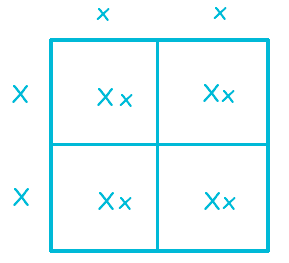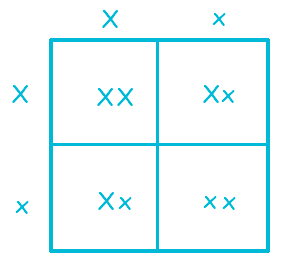Maths and Biology - Probabilities
This section refers to the work of the great biologist Gregor Mendel, who initiated the genetic revolution, being the first to understand the mechanisms of inheritance.
To illustrate the use of Maths by Mendel, I will briefly describe his great discovery.
He was very good at cultivating peas at his monastery and he was interested in the different traits that his plants displayed, like seed (pea) colour (yellow or green), seed surface (smooth or wrinkled), types and colours of pods, flower colour (white or purple),etc. It studied 7 different traits of peas and each of them could assume any of two varieties.
Self or cross-pollination
Pea plants can self-pollinate or cross-pollinate. Self-pollination occurs when the whole process occurs in the same flower, e.g., the pollen from the anters enter the ovary next to it, in which the seeds will form. In cross-pollination the pollen produced in the anthers of one flower travel to the ovary of another flower.
What Mendel did
He manually cross-polinate a plant that produces green seeds and one that produces yellow seeds, by taking the pollen from one and depositing in the ovary of the other. New seeds developed from this crossing and, surprisingly, they were all yellow (F1 generation). Next, he grew new plants from these yellow seeds obtained and allowed the new plants to self-pollinate and obtained a new batch of seeds (F2 generation). He took the time to count all this latest seeds ( yes, scientific work is often painstaking) : there was 6022 yellow seeds and 2001 green seeds. Interestingly, the green seeds appeared again! Also interesting was the proportion: approximately 3 yellow seeds for each green seed. He also repeated the experiment in regard to the other 6 traits of the plants and the same ratio 3:1 was repeated every time.
How he managed to explain the results
He supposed that the gene (I am using this term to make it simpler for you although the term gene was not yet in use at the time) that codes for a certain trait, let´s say seed colour, came in two varieties (or alleles), one that codes for green seeds and other that codes for yellow seeds. I will represent the allele for yellow as X and that for green as x. X was considered dominant over x because when they meet the X takes over. That explain why the crossing between yellow and green seed plants produced only yellow seeds.
Diagrams for probabilities
Let´s suppose that the yellow plant provided 2 alleles X and that the green plant provided 2 alleles x. This crossing could be represented by the Punnet square 1:

Punnet square 1 : Breeding the F1 Generation
The result here would always be Xx. Because X (yellow) is dominant, all the offspring (generation F1) would be yellow. That is what Mendel observed.
Next, Mendel bred the generation F1 to obtain F2:

Punnet square 1 : Breeding the F2 Generation
This time, there are four possibilities: XX, Xx and xx. XX and Xx give yellow seeds and only xx gives green seeds. There are four possible outcomes, equally probable. That means out of 4 possibilities , there 3 possibilities of obtaining yellow seeds and 1 possibility of green. That explains the ratio 3:1 observed by Mendel when counting seeds!
It is particularly interesting to observe that there is no blending of traits, like a purple flower mixing with a white flower giving a pink flower. The traits are preserved, but with different probabilities.
This mathematical work in Biology paved the way to all genetic theories we have today!
NEXT - Biology and Combinatorial analysis
DNA: the four letter code and the independent assortment in meiosis >>
